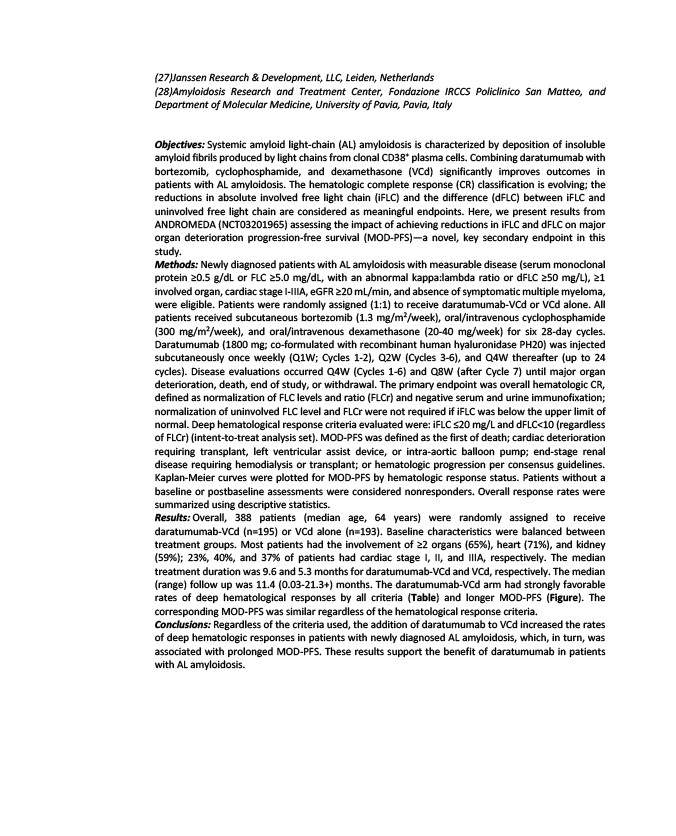
(27)Janssen Research & Development, LLC, Leiden, Netherlands
(28)Amyloidosis Research and Treatment Center, Fondazione IRCCS Policlinico San Matteo, and
Department of Molecular Medicine, University of Pavia, Pavia, Italy
Objectives: Systemic amyloid light-chain (AL) amyloidosis is characterized by deposition of insoluble
amyloid fibrils produced by light chains from clonal CD38+ plasma cells. Combining daratumumab with
bortezomib, cyclophosphamide, and dexamethasone (VCd) significantly improves outcomes in
patients with AL amyloidosis. The hematologic complete response (CR) classification is evolving; the
reductions in absolute involved free light chain (iFLC) and the difference (dFLC) between iFLC and
uninvolved free light chain are considered as meaningful endpoints. Here, we present results from
ANDROMEDA (NCT03201965) assessing the impact of achieving reductions in iFLC and dFLC on major
organ deterioration progression-free survival (MOD-PFS)—a novel, key secondary endpoint in this
study.
Methods: Newly diagnosed patients with AL amyloidosis with measurable disease (serum monoclonal
protein ≥0.5 g/dL or FLC ≥5.0 mg/dL, with an abnormal kappa:lambda ratio or dFLC ≥50 mg/L), ≥1
involved organ, cardiac stage I-IIIA, eGFR ≥20 mL/min, and absence of symptomatic multiple myeloma,
were eligible. Patients were randomly assigned (1:1) to receive daratumumab-VCd or VCd alone. All
patients received subcutaneous bortezomib (1.3 mg/m2/week), oral/intravenous cyclophosphamide
(300 mg/m2/week), and oral/intravenous dexamethasone (20-40 mg/week) for six 28-day cycles.
Daratumumab (1800 mg; co-formulated with recombinant human hyaluronidase PH20) was injected
subcutaneously once weekly (Q1W; Cycles 1-2), Q2W (Cycles 3-6), and Q4W thereafter (up to 24
cycles). Disease evaluations occurred Q4W (Cycles 1-6) and Q8W (after Cycle 7) until major organ
deterioration, death, end of study, or withdrawal. The primary endpoint was overall hematologic CR,
defined as normalization of FLC levels and ratio (FLCr) and negative serum and urine immunofixation;
normalization of uninvolved FLC level and FLCr were not required if iFLC was below the upper limit of
normal. Deep hematological response criteria evaluated were: iFLC ≤20 mg/L and dFLC<10 (regardless
of FLCr) (intent-to-treat analysis set). MOD-PFS was defined as the first of death; cardiac deterioration
requiring transplant, left ventricular assist device, or intra-aortic balloon pump; end-stage renal
disease requiring hemodialysis or transplant; or hematologic progression per consensus guidelines.
Kaplan-Meier curves were plotted for MOD-PFS by hematologic response status. Patients without a
baseline or postbaseline assessments were considered nonresponders. Overall response rates were
summarized using descriptive statistics.
Results: Overall, 388 patients (median age, 64 years) were randomly assigned to receive
daratumumab-VCd (n=195) or VCd alone (n=193). Baseline characteristics were balanced between
treatment groups. Most patients had the involvement of ≥2 organs (65%), heart (71%), and kidney
(59%); 23%, 40%, and 37% of patients had cardiac stage I, II, and IIIA, respectively. The median
treatment duration was 9.6 and 5.3 months for daratumumab-VCd and VCd, respectively. The median
(range) follow up was 11.4 (0.03-21.3+) months. The daratumumab-VCd arm had strongly favorable
rates of deep hematological responses by all criteria (Table) and longer MOD-PFS (Figure). The
corresponding MOD-PFS was similar regardless of the hematological response criteria.
Conclusions: Regardless of the criteria used, the addition of daratumumab to VCd increased the rates
of deep hematologic responses in patients with newly diagnosed AL amyloidosis, which, in turn, was
associated with prolonged MOD-PFS. These results support the benefit of daratumumab in patients
with AL amyloidosis.